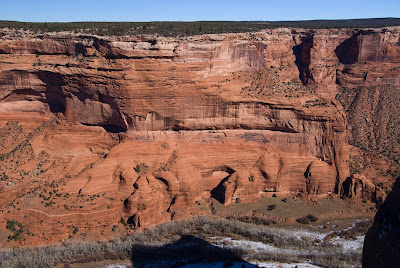Thousands of years ago, this canyon was the home of the Anasazi people. They had some cluster homes set against the cliff face, such as Antelope House.
The cliffs loom 600 to 800 feet above the community house, providing shelter and seclusion.
Antelope House gets its name from the art on the cliff wall nearby. The art dates back perhaps 150 to 200 years, and is attributed to an artist from the Hopi Nation. Set above a ledge perhaps 50 feet above the canyon floor, the art is drawn, life-sized, from a precarious perch that most of us would feel uncomfortable getting to, much less working on.
Those vertical walls became home to the Anasazi people. Just east of Antelope House is a formation called (if I remember correctly) Fortress Rock, on the left side of the photo below. On its face are holes into which wooden stakes could be placed. The Anasazi could then climb these stakes, removing them as they go, providing escape and shelter from their enemies.
The canyon floor was not the only area used for living. There were many places on the cliffs themselves where the foundations and some walls of these community homes remain.
To give you a sense of scale, that house is located in a horizontal seam midway up the cliff face. The image below is a base-to-top view of that wall with the dwelling remnants in the center.
Imagine having to climb that wall to get to your home, carrying all your food, water and fuel. I guess you would get irritated if you forgot something...
I think I will return to Canyon de Chelly. First, I want to get some early morning and late afternoon shots from the rim. Second, there is a jeep tour through the base of the canyon. I want to do that. It leaves at 9:00, and when I was there last week, I just was not about to get up early enough to be ready for a jeep tour at 9. As both MacArthur and Arnold S. said, I'll be back.










No comments:
Post a Comment